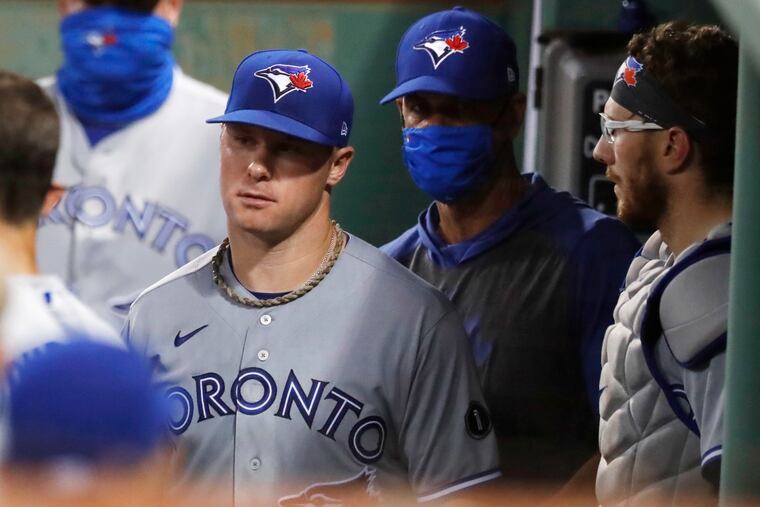In signing Chase Anderson, Phillies showed they didn’t put much stock in short 2020 season
An ignominious five-homer inning at Yankee Stadium in September distorted the numbers of a 33-year-old right-hander who has averaged 149 innings over the last five full seasons.

Take a peek at Chase Anderson’s page at Baseball-Reference.com, the millennial’s version of the back of a baseball card and no less essential. What’s the first thing you notice?
It’s that 2020 ERA, isn’t it?
“I forget what it was,” Anderson said by phone. “It was ... it was really high. That’s all I know.”
It was 7.22, to be exact, which prompts a reasonable question: Why on earth would the Phillies give $4 million to a starting pitcher who had a 7.22 ERA last year? Have they gone mad?
Not quite. In signing Anderson as a free agent two weeks ago, the Phillies made a calculation that most teams wrestled with this winter, namely that drawing conclusions about a player based on a two-month season in a pandemic is akin to an artist painting a portrait by looking at someone’s reflection in a fun-house mirror.
“When you look at some of the numbers, it’s difficult because it was a 60-game season,” Phillies president of baseball operations Dave Dombrowski said. “You’ll run into individuals who had COVID and how it affected them coming back. Or they had an injury, trying to come back more quickly than they normally would. Just pure streaks, we know some guys who can be really good for 30 games and fall off, or vice versa.”
For some pitchers, in particular, numbers were distorted by one odious outing – or, in Anderson’s case, one infamous inning.
It happened Sept. 17 at Yankee Stadium. In a span of 14 pitches, Anderson gave up five home runs. Brett Gardner, DJ LeMahieu and Luke Voit took him deep in succession – all on first pitches. After striking out Aaron Hicks, he allowed back-to-back homers to Giancarlo Stanton and Gleyber Torres in the Toronto Blue Jays’ 10-7 loss.
Anderson didn’t even make history. He merely matched it, becoming the second pitcher ever to allow five homers in one inning. Michael Blazek, coincidentally Anderson’s former teammate with the Milwaukee Brewers, did it three years earlier.
“It’s bam-bam-bam-bam-bam, and it’s like, what happened? It went by so fast,” Anderson said. “Your mind is kind of racing. I think I was tipping a pitch. I was doing something that they picked up on pretty quickly because there’s definitely a difference from [three] strikeouts in [the previous] two innings to five homers in one inning. You take that one inning away and my year is totally different.”
To be clear, stripping out that fourth inning in New York wouldn’t have turned Anderson’s season into Trevor Bauer’s. It was only the nadir of a four-game stretch in September in which the Yankees, Boston Red Sox, and New York Mets knocked him around for 20 runs in 12 innings.
But that New York nightmare, without which Anderson’s ERA would have been 5.51, helped cost him $5.5 million. The Blue Jays declined the 33-year-old right-hander’s $9.5 million option after the season, putting him on the market in a slow winter for mid-level free agents.
The Phillies focused on Anderson’s larger body of work. In his last three seasons with Milwaukee, his ERA rose from career-best 2.74 in 2017 to 3.93 in 2018 and 4.21 in 2019. He’s also a fly-ball pitcher, a breed that doesn’t always fare well at Citizens Bank Park.
Zoom out even more, though, and from 2015 to 2019, Anderson averaged 149 innings per season with a 3.93 ERA (league average was 4.17). In a year when teams will be reconditioning pitchers for the rigors of a six-month season, there’s value in an innings-eater with a league-average ERA.
Dombrowski said the Phillies relied on previous years’ scouting reports to make some offseason decisions. They also likely sought outside appraisals. Derek Johnson, Anderson’s pitching coach with the Brewers, worked with new Phillies pitching coach Caleb Cotham last season with the Cincinnati Reds. It’s a safe bet that Anderson’s name came up between them.
And then there was a Zoom call between Anderson, Cotham, and manager Joe Girardi.
“I was a little bit starstruck, I was telling my agent, from talking to [Girardi] just because of the impact he’s made as a player and as a manager for a long time,” Anderson said. “That was really cool. I’m looking forward to playing for such a legendary figure.”
The Phillies will fill two spots in the season-opening rotation from among Anderson, lefty Matt Moore, holdover Vince Velasquez, top prospect Spencer Howard, and non-roster invitee Ivan Nova. It’s possible they will go with the experience of Moore and Anderson or Velasquez early in the season, while Howard builds his arm strength to be more of a factor late.
But it will all be sorted out in spring training.
“I don’t ever like to have anything given to me,” Anderson said. “My best year came in ’17 and I had to compete for a spot in that rotation in Milwaukee. It brought out the best in me, gave me that edge that I needed. I like that challenge.”
There are two things that Anderson said he knows for certain: He’s best suited as a starter, and he won’t be defined by one dreadful inning.
“Your ERA before that was pretty good and it balloons,” he said. “At the time you’re trying to see what happened, how did it happen? But after that you want to get back out and prove that it was a fluke deal. I’m looking to do that this year.”